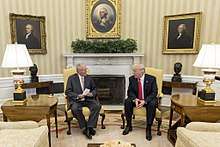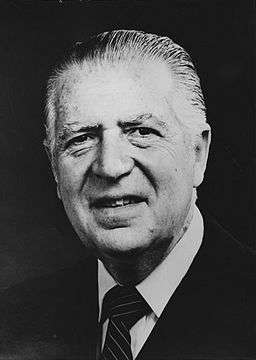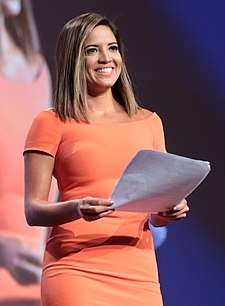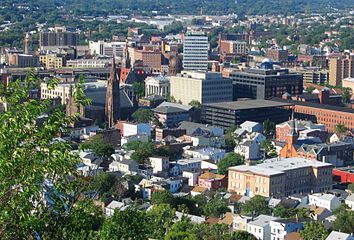Peruvian Americans
Peruvian Americans are Americans of Peruvian descent. Among Peruvian Americans are those of European ancestry, (including Italian, French and German, but mostly Spanish), as well as Mestizo, Amerindian and African background or a mix of any of these. A significant number are of entirely or partial Chinese and/or Japanese heritage.
 President Pedro Pablo Kuczynski, a Peruvian American, meets with US President Donald Trump in the Oval Office in 2017. | |
| Total population | |
|---|---|
| 684,345 (2018)[1]
0.21% of the U.S. population (2018)[1] | |
| Regions with significant populations | |
| |
| Languages | |
| |
| Religion | |
| |
| Related ethnic groups | |
| Americans, Peruvians |

| This article is part of a series on the |
| Culture of Peru |
|---|
_alternative_version.svg.png) |
|
History
RecentPresidency of Martín Vizcarra (2018-current) |
|
Arts and literature
|
|
Entertainment
|
|
|
|
Peru portal |
| Hispanic and Latino Americans |
|---|
|
National origin groups
|
|
Political movements
|
|
Organizations
|
|
Ethnic groups |
|
Lists
|
According to the U.S. Census Bureau 2018 American Community Survey 1-Year Estimates, as of 2018, 684,345 U.S. residents identify themselves as being of Peruvian origin.[1] Approximately 62% of Peruvian Americans were born in Peru, with a growing population of Peruvian Americans being born in the United States.
History
Peruvian Americans immigrated to the United States in four major waves. Small but significant waves of immigration occurred in San Francisco during the gold rush (along with Chilean miners beginning in 1848) and the Metro Detroit area in the 1950s. Another wave of immigration occurred again early in the twentieth century, due largely to the burgeoning textile industry in New York and New Jersey. In the 1950s, there were a reported approximate 100 Peruvian families that resided in Paterson, New Jersey.[6]
Beginning in the 1970s another wave of Peruvians arrived in the United States, most of whom were fleeing Peru's militaristic government under the dictatorships of Juan Velasco Alvarado and Francisco Morales Bermudez both marked by coups and socio-economic instability. The 1980s and 1990s saw the most significant influx of Peruvians to U.S. shores, this time in response to the hyperinflation crisis that plagued the Peruvian economy, internal unrest in Peru by terrorist groups, and an authoritarian government headed by Peruvian President Alberto Fujimori.[7]
Immigrants often come from urban areas of Peru, especially Lima, and the majority settle in the New York City metropolitan area—particularly in Paterson and Passaic in New Jersey and the New York City borough of Queens. Peruvian Americans are also clustered in the metropolitan areas of Miami, Florida; Los Angeles; Houston, Texas; Washington, D.C.; and Virginia.[7]
Recently, Peru has enjoyed economic growth and political stability since the start of the millennia. As a result, there has been a decline in the amount of Peruvian immigration to the United States unto 2019 under economic pretenses and instead for education.
Settlement in the United States
The states with the largest number of Peruvian Americans are Florida, California, New Jersey, and New York. Texas and Virginia are also home to significant communities of people of Peruvian descent.
Little is known about the earliest Peruvian immigrants who came to the United States during the California gold rush. Later Peruvian immigrants began arriving in the early twentieth century to work in textile mills in Paterson, New Jersey, which is now home to one of the largest Peruvian communities in the United States. Paterson has a significant number of businesses run by Peruvian Americans, as well as social and political organizations, and remains a destination for Peruvian immigrants of all social classes.[7]
Immigration
Undocumented Peruvian Americans make up less than 1% of the total illegal alien population in the United States according to 2015 report from the US Department of Homeland Security.[7][8]
Fewer than 1000 foreign born Peruvians immigrate to the United States per year.
Lifestyle and culture
The most famous and first aspect of Peruvian culture that deals with the United States is the book, "The Incas's Florida" La Florida del Inca written at the end of sixteenth century by the Inca Garcilaso de la Vega. Garcilaso's book details the travels of the explorer Hernando de Soto who had participated in the Forty-Years War between the Incas and the Spanish (1531–1571) and who later came to the lands that would become part of the United States and that the Spanish called "Florida."
The most popular dishes of Peruvian food in the U.S. include ceviche (raw fish "cooked" in lime juice), papa a la huancaína, and anticuchos y tamales. Peruvian cuisine is often recognized for being one of the most diverse and appreciated of the world's cuisines, with influences including European, Native American, and African. Since there is a sizable Chinese and Japanese minority in Peru, an Asian influence has also been deeply incorporated in Peruvian cuisine. There are Chifas, or Asian-style Peruvian restaurants that serve typical Chinese or Japanese food with a Peruvian culinary influence. Inca Kola, a soda that originated in Peru, is sold in many heavily concentrated Latin American areas.
The extended family commonly serves an economic function, too, with some new immigrants temporarily living with extended family already established in the United States, and in expensive urban centers, such arrangements sometimes are permanent.[9]
Socioeconomic status
Nearly half of Peruvians have resided in the United States for over 20 years, with 46% of foreign-born Peruvians reported to have lived in the United States for 20 years or more.[10]
Despite being a relatively recent ethnic group, the median household income for Peruvians meets the average American household income and 44% of Peruvians born in the United States over the age of 25 have college degrees,[11] exceeding the US national average of 24%.
Around 90% of Peruvians lived above the poverty rate in 2017, with a poverty rate of 10% compared to the United States national average of 12.3% that same year.
Activism
The Peruvian American Coalition in Passaic, New Jersey[12] functions as an activist organization on behalf of the overall welfare of Peruvian Americans.
Demographics
Peruvians have settled throughout the United States, migrating particularly to Northern New Jersey and the New York City Metropolitan Area, the Miami metropolitan area, the Washington Metropolitan Area, and the Los Angeles metropolitan area.[13]
Notably, a rapidly growing number of Peruvian Americans, about 10,000 in 2018,[5] have established an increasingly prominent community in Paterson, New Jersey,[14] which is considered by many to be the capital of the Peruvian Diaspora in the United States,[3] partially owing to the presence of the Peruvian Consulate. Market Street, the Little Lima in downtown Paterson, is the largest Peruvian American enclave and is lined with Peruvian-owned restaurants, bakeries, delicatessens, bodegas, travel agencies, and other businesses. The Peruvian American community has expanded into Paterson's neighboring areas of Fair Lawn, Elmwood Park, Clifton, and Passaic in Northern New Jersey as well, all within the New York City Metropolitan Area. The annual Peruvian Independence Day Parade is held in Paterson.[4][15]
States with highest Peruvian population
The 10 states with the largest Peruvian population were (Source: Census 2017):[16]
- Florida – 100,965 (0.5% of state population)
- California – 91,511 (0.2% of state population)
- New Jersey – 75,869 (0.9% of state population)
- New York – 66,318 (0.3% of state population)
- Virginia – 29,096 (0.4% of state population)
- Texas – 22,605 (0.1% of state population)
- Maryland – 18,229 (0.3% of state population)
- Connecticut – 16,424 (0.5% of state population)
- Georgia – 10,570 (0.1% of state population)
- Illinois – 10,213 (0.2% of state population)
The U.S. state with the smallest Peruvian population (as of 2010) was North Dakota with 78 Peruvians (less than 0.1% of state population).
Metro Areas
The top 5 US metropolitan areas with the largest Peruvian population were:
- New Jersey-New York Greater Area – 182,672
- Miami – 81,729
- Washington, D.C. – 53,961
- Los Angeles metropolitan area – 48,380
- San Francisco Bay Area – 26,969
Notable people
| Lists of Americans |
|---|
| By U.S. state |
| By ethnicity or nationality |
|
|
|
|
|
|
|
|
|
Artists
- Alex Acuña – Peruvian drummer and percussionist
- Miguel Harth-Bedoya – Peruvian conductor
- Roberto Eyzaguirre – classical pianist and famed piano pedagogue.
- Gabriela Lena Frank – American pianist and composer of contemporary classical music.
- Josh Keaton – actor, singer and musical producer
- Isabela Moner – actress, voice actress, singer, songwriter, dancer and ukulele player
- Adele Morales – American painter and memoirist. He is of Spanish and Peruvian descent.
- Plavka – American singer of Croatian and Peruvian origin
- Susana Raab – Award-winning fine arts photographer based in Washington, DC
- Kat Reeder – artist, illustrator and graphic designer
- Ginger Reyes – rock musician
- Alex Rivera – U.S. film maker specialising in films about labor, immigration, and politics
- Carmen Giménez Smith – American poet, writer, and editor
- Tony Succar – Peruvian born American musician, composer, arranger and producer
- Yma Sumac – indigenous soprano
- Mario Testino – photographer
- Boris Vallejo – Peruvian-born American painter
- Alberto Vargas – Peruvian painter
Entertainment
- Jorge Andres – Award Winning National Sportscaster and Former ESPN Sportscenter Anchor
- Alexis Amore – pornographic actress
- Daniella Alonso – American actress. Her father is from Peru, of Japanese origins.
- Miguel Arteta – Son of a Peruvian, director of film and television, known for his independent film Chuck & Buck (2000), for which he received the Independent Spirit John Cassavetes Award, and Cedar Rapids.[17]
- Amber Barretto – American actress
- David Bernal – illusionary dancer
- Benjamin Bratt – actor, Peruvian on his mother's side
- Pepe Barreto – community and entertainment reporter for KMEX-TV, Channel 34
- Jorge Benitez – (also known as George Benitez) former U.S. soccer forward
- Julio C. Canani – Peruvian trainer in American Thoroughbred horse racing who has won three Breeders' Cup races.
- David Torrence – athlete, he has a US record of 1000 meters; and he has also represented Peru at the 2016 Rio de Janeiro Olympic Games. He was born in Japan and has Peruvian ancestry per his mother; his father is American.
- Roberto Carcelen – Peruvian-American cross-country skier
- Carmen Carrera – American model of Peruvian and Puerto Rican descent
- Diego Chávarri – footballer
- Cesar Conde – Chairman NBC Universal International Group & Telemundo Enterprises
- Kenny Florian – mixed martial artist
- Richard Green – football (soccer) defender
- Kathleen Herles – American voice actress
- Q'orianka Kilcher – actress
- Pedro Pablo León – football forwarder(soccer)
- Alex Olmedo – former tennis player from Peru with American citizenship[18]
- Luis Palomino – Peruvian American mixed martial artist who competes in the lightweight division
- Edgar Prado – jockey
- Rosa Salazar – American actress of Peruvian descent
- Tom Segura – Peruvian-American stand-up comedian
- Daniel Tuccio – Peruvian-American television reporter/news anchor
- Jose Valdivia, Jr. – jockey in American thoroughbred horse racing
- Carlos De Valdez (1894–1939) – Peruvian film actor who appeared in around forty American films. He spend the last years of his life in United States (where he died).[19]
Politics
- Juan Bandini – (1800–1859) an early settler of what would become San Diego, California
- Fernando Belaúnde Terry – American educator, former President of Peru (1963–1968; 1980–1985)
- Robert Garcia – Mayor of Long Beach, California
- Augusto B. Leguía – Businessman, former Prime Minister of Peru, former President of Peru (1908–1912; 1919–1930)
- Pedro Pablo Kuczynski – former President of Peru (2016–2018)
- Alejandro Toledo – former President of Peru (2001–2006)
As of 2020, four Presidents of Peru are or were Peruvian-Americans.
.jpg) Augusto Leguía (1908-1912; 1919-1930)
Augusto Leguía (1908-1912; 1919-1930) Fernando Belaúnde Terry, 80th President of Peru (1963-1968;1980-1985)
Fernando Belaúnde Terry, 80th President of Peru (1963-1968;1980-1985).jpg) Alejandro Toledo, 84th President of Peru (2001-2006)
Alejandro Toledo, 84th President of Peru (2001-2006).jpg)

Sciences
- Anthony Atala – M.D., W.H. Boyce Professor and Director of the Wake Forest Institute for Regenerative Medicine, and Chair of the Department of Urology at the Wake Forest University School of Medicine in North Carolina. He is a Peruvian born, but American raised.[20]
- Carlos Bustamante – biologist
- Carlos Castaneda – philosopher
- Carlos I. Noriega – astronaut
- Wenceslaus Sarmiento – also known as W.A. Sarmiento, Peruvian-born American modernist architect
- Barton Zwiebach – physicist working on String Theory
Journalism
- Daniel Alarcón – Peruvian born, American raised author
- Marie Arana – editor, journalist and Peruvian born author
- Mandalit del Barco – general assignment reporter for National Public Radio
- Monica Brown (author) – children's book author, Peruvian on her mother's side
- Lorenzo O'Brien – writer-producer
- Alex Kuczynski – journalist
- Jaime Bayly – writer, journalist and television presenter
Other
- Arthur Chin – America's first flying ace in World War II
- David Utrilla – 31st member of the Utah Corps of Consuls
References
- "B03001 HISPANIC OR LATINO ORIGIN BY SPECIFIC ORIGIN - United States - 2018 American Community Survey 1-Year Estimates". U.S. Census Bureau. 1 July 2018. Retrieved 25 November 2019.
- "Yearbook of Immigration Statistics: 2011 Supplemental Table 2". U.S. Department of Homeland Security. Retrieved 8 July 2012.
- "A Brief History of Peruvian Immigration to the United States". yumimmigrantcity.com. Archived from the original on 31 July 2013. Retrieved 3 April 2013.
- "Photos: Annual Peruvian Day Parade in Passaic County. The parade makes its way down Market Street in Paterson". 27 July 2014. Retrieved 27 July 2014.
- Rodrigo Torrejon (16 June 2018). "In Paterson, boisterous cheers for Peru's return to the World Cup after 36 years". NorthJersey.com – part of the USA TODAY network. Retrieved 16 June 2018.
- Baía, Larissa Ruiz (1999). "Rethinking Transnationalism: Reconstructing National Identities among Peruvian Catholics in New Jersey". Journal of Interamerican Studies and World Affairs. 41 (4): 93–109. doi:10.2307/166193. ISSN 0022-1937. JSTOR 166193.
- "Gale Encyclopedia of Multicultural America, 3rd Edition – Gale – 978-1414438061". cengage.com. Retrieved 26 April 2019.
- "Population Estimates: Illegal Alien Population Residing in the United States" (PDF). US Department of Homeland Security.gov. n.d.
- Packel, J. (2014). Peruvian Americans. In Gale (Ed.), The Gale encyclopedia of multicultural America (3rd ed.). Farmington, MI: Gale.
- "Facts on Latinos of Peruvian origin in the U.S." Pew Research Center's Hispanic Trends Project. Retrieved 5 January 2020.
- Bureau, U.S. Census. "American FactFinder – Results". factfinder2.census.gov. Archived from the original on 12 February 2020. Retrieved 4 October 2017.
- Lindy Washburn (25 August 2014). "A new playbook for hospitals: How investors pursue a financial turnaround". Retrieved 26 August 2014.
- "Yearbook of Immigration Statistics: 2010 Supplemental Table 2". U.S. Department of Homeland Security. Retrieved 11 April 2011.
- Karen Sudol (27 July 2013). "North Jersey Peruvians celebrate Peru's independence with a flag raising in Paterson". Retrieved 28 July 2013.
- "Photos: Parade celebrates Peruvian heritage". 26 July 2015. Retrieved 26 July 2015.
- "American FactFinder – QT-P10: Hispanic or Latino by Type: 2010". Factfinder2.census.gov. Archived from the original on 25 January 2015. Retrieved 4 October 2017.
- "Miguel Arteta:Overview". MSN. Archived from the original on 13 November 2013. Retrieved 24 April 2011.
- "While Critics Cry, He Wins", Lakeland Ledger, 23 August 1959, page 19.
- Pitts, Michael R. Western Movies: A Guide to 5,105 Feature Films. McFarland, 2012.
- "Scientist at Work: Anthony Atala". Annparson.com. Archived from the original on 25 May 2017. Retrieved 4 October 2017.
Further reading
- De Ferrari, Gabriella. Gringa Latina: A Woman of Two Worlds (Houghton Mifflin, 1996).
- Packel, John. "Peruvian Americans." Gale Encyclopedia of Multicultural America, edited by Thomas Riggs, (3rd ed., vol. 3, Gale, 2014), pp. 467–476. online
- Paerregaard, Karsten. "Inside the Hispanic Melting Pot: Negotiating National and Multicultural Identities among Peruvians in the United States.” Latino Studies 3 (2005): 76–96.
External links
- "La Revista de PeruanosEnUSA.net – Artículos de interés para los peruanos residentes en el extranjero". Peruanosenusa.net. Retrieved 4 October 2017.
- "Welcome curito.com". Curito.com. Retrieved 4 October 2017.

